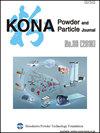用流动反应器连续合成精密金纳米颗粒
IF 3.2
4区 材料科学
Q3 ENGINEERING, CHEMICAL
引用次数: 3
摘要
利用流动化学合成纳米粒子有可能以更低的价格提高精密工程纳米材料的大规模可及性。这一目标很难实现,主要是由于反应器结垢和缺乏有效的试剂混合,特别是在那些放大的系统中。本研究旨在通过集成具有静态混合的液-液两相分段流系统来克服这两个挑战。该策略被应用于利用柠檬酸还原化学合成金纳米颗粒(AuNPs)。结果表明,采用双相流策略可以消除反应器的污染。结果表明,合成的AuNPs总体平均粒径为15.5 nm,多分散性指数(PDI)为0.07,重现性为±6.4%。双相流体系的反应产率为88.7±1.1%,反应通量为60 m L/h,持续8小时。本文章由计算机程序翻译,如有差异,请以英文原文为准。
Continuous Synthesis of Precision Gold Nanoparticles Using a Flow Reactor
Nanoparticle synthesis using flow chemistry has the potential to enhance the large-scale accessibility of precision-engineered nanomaterials at lower prices. This goal has been difficult to achieve primarily due to reactor fouling and the lack of efficient reagent mixing encountered, especially in those scaled-up systems. The present study aimed to overcome the two challenges by integrating a liquid-liquid biphasic segmented flow system with static mixing. This strategy was applied to the synthesis of gold nanoparticles (AuNPs) using citrate reduction chemistry. It was demonstrated that reactor fouling was eliminated by implementing the biphasic flow strategy. As a result, the overall mean particle size of the as-synthesized AuNPs was measured to be 15.5 nm with a polydispersity index (PDI) of 0.07, and with the reproducibility of ± 6.4 %. The biphasic flow system achieved a reaction yield of 88.7 ± 1 .1 % r eliably with a throughput of 60 m L/hour up to 8 hours.
求助全文
通过发布文献求助,成功后即可免费获取论文全文。
去求助
来源期刊

KONA Powder and Particle Journal
工程技术-材料科学:综合
CiteScore
8.40
自引率
4.90%
发文量
35
审稿时长
>12 weeks
期刊介绍:
KONA publishes papers in the broad field of powder science and technology, ranging from fundamental principles to practical applications. Papers describing technological experience and critical reviews of existing knowledge in special areas are also welcome.
 求助内容:
求助内容: 应助结果提醒方式:
应助结果提醒方式:


